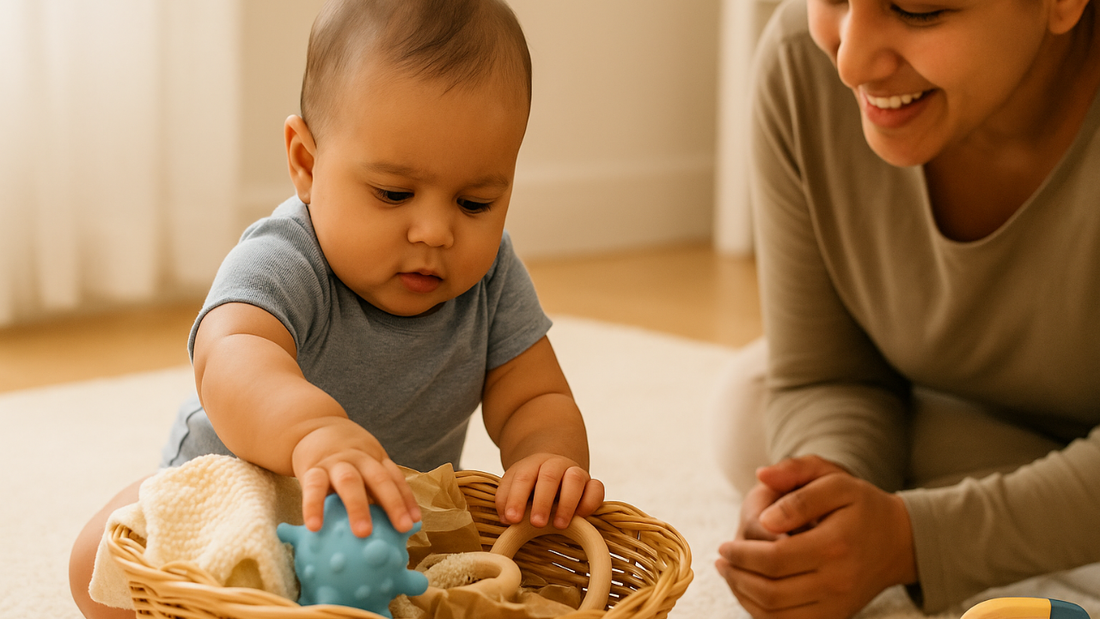
Soft, Squishy, Bumpy: Exploring Texture with Babies
LiLLBUDBabies are born explorers. Before they learn to talk or crawl, they are discovering the world with their senses–primarily through touch. Whether it is the smoothness of a blanket or the roughness of a wooden block, texture is a big part of early exploration.
That’s where texture play for babies comes in. These easy, hands-on experiences lay the foundation for important motor development, cognitive growth, and sensory development.
In this article we are sharing easy tactile activities to try at home and explore how tactile experiences support your baby’s brain and body and show how the right toys can turn everyday play into meaningful learning.
Why Texture Matters in Baby Development
One of the first senses to develop in the womb is touch, which has a big influence on how your baby learns even now. Every time your baby rubs, pats, or presses a textured item, they are:
- Learning cause and effect
- Improving their motor skills
- Creating neural connections for cognitive development
-
They gain confidence in exploring their environment
These activities help babies reach important developmental milestones like reaching, grasping, and solving problems.
Texture play is not just fun–it is also fundamental.
Easy Tactile Activities for Babies (0 to 12 Months)
Below are some engaging and safe tactile activities that you can introduce to your baby:
1. Texture Baskets
Take a basket filled with baby-safe objects such as a soft washcloth, silicone brush, rubber ball, crinkly paper, and smooth wooden toys. Let your baby explore, taste, and feel each one at their own pace.
2. Fabric Feely Game
Lay out different fabrics–cotton, velvet, fleece, mesh. Allow your baby to crawl or reach in to differentiate the difference. Describe how each one feels: “This is smooth… this one is bumpy!”
3. Mess-Free Sensory Bags
Put hair gel, water beads, or pom-poms into a ziplock bag and secure it tightly (tape the edges if necessary). Place on the floor for tummy time or highchair play and allow your baby to squish and poke away.
4. Food Texture Fun (6+ months)
When your baby begins solids, offer safe textures such as mashed banana, cooked pasta, or rice. Let them explore with their hands. It’s messy–but it’s also powerful sensory learning.
5. Outdoor Texture Walk
Take your baby outdoors and gently guide their hands over leaves, grass, tree bark, and rocks. Nature offers countless sensory touch ideas along with fresh air and sunshine!
The Power of Montessori Learning Toys for Texture Exploration
Montessori toys are specifically designed to engage your child’s senses in intentional, age-appropriate ways. Most Montessori learning toys focus on natural materials and offer rich textures–without the overstimulating lights and sounds of electronic toys. Great examples include:
- Montessori fabric books with zippers, buttons, and textures
- Object permanence boxes for tactile cause-and-effect play
- Stacking toys with sanded wooden surfaces
-
Textured balls for rolling, squeezing, and mouthing
These toys are not only beautiful–they’re some of the finest brain development toys because they allow your baby to discover through doing.
How Texture Play Supports Brain and Body
Texture exploration helps develop coordination among your baby’s senses and muscles. Here's how:
- Cognitive development: Paying attention to differences between textures enhances memory, comparison skills, and focus.
- Motor development: Holding or grasping bumpy, slippery, or soft objects strengthens finger muscles and hand-eye coordination
- Emotional development: Regular sensory exposure can foster babies feel safe, calm, and curious
- By providing texture-rich play to your baby, you're fostering joyful exploration and the connection between body and brain.
Let Them Feel It All
Every new texture, whether it's smooth or hard, squishy or scratchy, offers your baby a chance to learn. As caregivers, we can facilitate that growth with simple materials, everyday moments, and developmentally rich Montessori toys that encourage exploration.
So let your baby experience the world–one soft, squishy, bumpy moment at a time.

